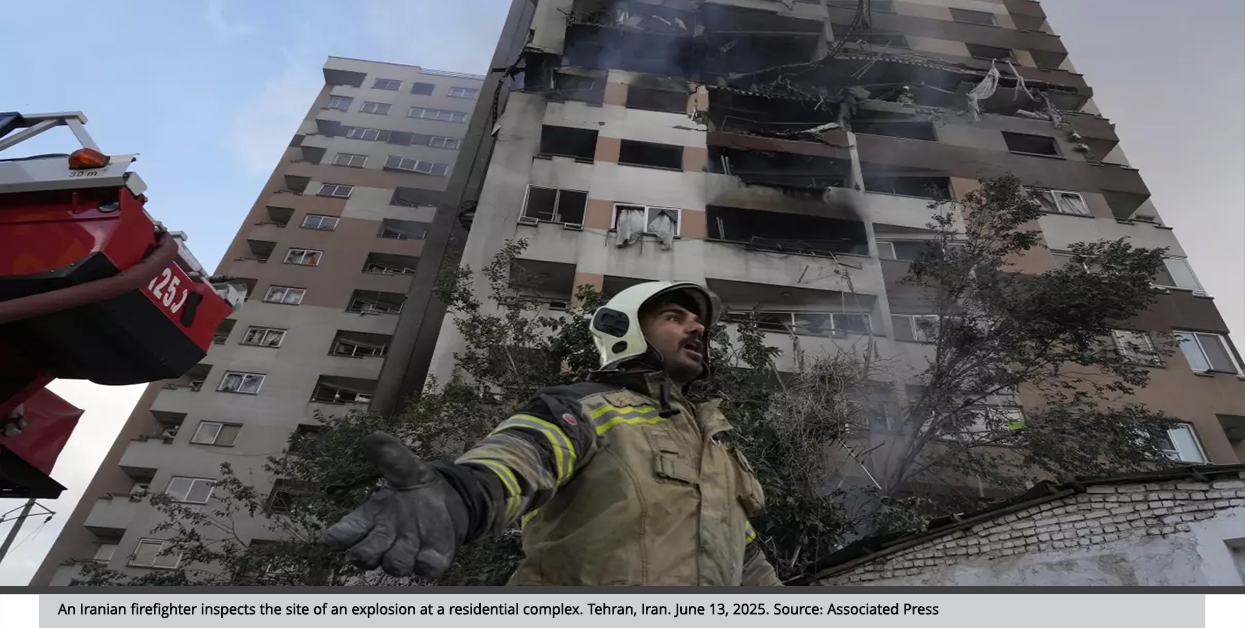The Paths of the Israeli Military Operation against Iranian Capabilities
The Israeli attacks targeting Iran’s military command structure and its defensive and offensive capabilities place the upcoming developments within a framework of several trends and trajectories. These can be outlined based on the overall events that have unfolded in the region and among Iran’s proxies since the outbreak of the war in the Gaza Strip. Additionally, the scale of the strikes suggests that they were not a passing event or merely a pressure tactic against Iran, but rather primarily aimed at consolidating the regional landscape and post-war order.
by STRATEGIECS Team
- Release Date – Jun 16, 2025
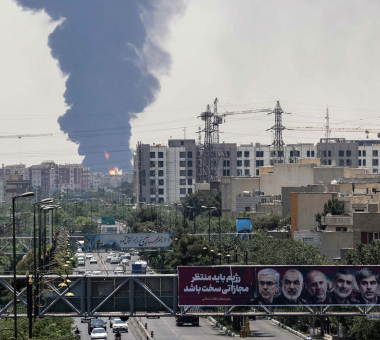
On the morning of June 13, Israel launched a military operation targeting Iranian capabilities. The operation included a series of strikes against Iran’s military and command infrastructure, carried out in several waves, that are still ongoing. These strikes resulted in the deaths of a number of Islamic Revolutionary Guard Corps (IRGC) commanders and nuclear scientists, as well as the destruction of military and nuclear facilities, including the Natanz Nuclear Facility.
In reality, the operation has triggered a new round of escalation between Israel and Iran—one that differs from previous confrontations in terms of objectives, strategies, and tactics. It also challenges the conventional framing of such events as mere escalations or a full-scale "war." This escalation can be seen as part of a long-standing covert war between the two nations that has spanned at least two decades, and as a significant development in their direct confrontations since October 7, 2023. This raises questions about what the coming days may hold, particularly in light of three potential scenarios—each tied to the nature and objectives of the Israeli attacks and Iran’s increasingly assertive responses.
The Military Operation Against Iranian Capabilities
Israel carried out a series of military strikes against Iran’s military command structure, nuclear facilities, and several other targets. During the first wave of attacks, Israel killed several top figures within Iran’s trinity of military leadership: the IRGC, the General Staff of the Armed Forces, and Khatam al-Anbiya Central Headquarters
Among those killed were IRGC Commander-in-Chief Hossein Salami, Chief of the General Staff Major General Mohammad Bagheri, Deputy Chief of the General Staff Gholam Ali Rashid, who also served as commander of the IRGC’s Khatam-al Anbiya Central Headquarters, as well as several senior air force leaders, including Aerospace Force Commander Brigadier General Amir Ali Hajizadeh, UAV Force (drones) Brigadier General Taher Pour, and Aerospace Air Defense Commander Brigadier General Davoud Shekhian. Supreme Leader Ali Khamenei’s top advisor and former security chief Ali Shamkhani was also killed.
The operation also included the assassination of nine prominent nuclear scientists, among them former Atomic Energy Organization chief Fereydoon Abbasi and nuclear physicist Mehdi Tehranchi, both of whom were involved in Iran’s nuclear weapons program.
Military facilities, including the Natanz nuclear site and Tabriz International Airport, were also destroyed. Subsequent waves of attacks expanded to include civilian targets and some energy infrastructure in what appeared to be more of a tactical warning strike than a full-scale strategic offensive.
Operationally, the Israeli attacks are seen as a continuation of an ongoing series of direct strikes targeting Quds Force commanders responsible for orchestrating Iran’s overseas operations, particularly in Syria and Lebanon, as well as Iran’s military infrastructure in both countries. These strikes also form part of a broader, indirect campaign targeting Iran’s regional proxies: Hezbollah in Lebanon, Hamas and Islamic Jihad in the Gaza Strip, the Houthis in Yemen, in addition to Syria itself prior to the regime’s consolidation.
These latest strikes occurred amid ongoing negotiations between Iran and the United States over Iran’s nuclear program and shortly after the expiration of a 60-day deadline set by U.S. President Donald Trump for Iran to accept the American terms of the deal.
In the same vein, the operation reveals the deep extent of Israeli infiltration into Iran—a penetration reminiscent of the one that previously dismantled Hezbollah’s leadership and military capabilities. The military operation included complex and multi-layered activities, such as the presence of Israeli intelligence agents on Iranian soil who carried out military operations, including the smuggling of advanced weaponry into Iran. These weapons were then used to destroy air defense batteries and carry out assassinations of military commanders and nuclear scientists.
Additionally, Israel launched cyberattacks that disrupted multiple Iranian air defense systems and radar networks. The operation also involved around 200 Israeli aircraft, which, according to Israeli military reports, targeted approximately 100 strategic military sites during the first wave of attacks.
This level of infiltration echoes the claim made by former Iranian President Mahmoud Ahmadinejad in June 2021 when he told CNN “the man who was in charge of the unit in Iran against Israel was an Israeli agent,” adding that “he was not acting alone, but was coordinating with around 20 other individuals within the same unit—all of whom were working for the Israeli Mossad.”
The foregoing indicates that the Israeli strike was not only designed to destroy specific targets—despite the wide range of these targets, as the operation is still ongoing—but also aimed to deprive Iran of the ability to respond effectively. The attacks have left Iran’s decision-making institutions in a state of shock and defensive posture, attempting to mitigate the impact of both the strikes that have already occurred and those anticipated.
Moreover, the operation included the destruction of ballistic and hypersonic missile platforms that were previously prepared for rapid retaliation against any Israeli attack. This places Israel’s moves on a spectrum of possible trajectories, some of which could potentially lead to achieving their ultimate objective of toppling the regime.
Iranian Response and Rapid Recovery from Shock
The Iranian response in this round of escalation showed several differences compared to previous reactions. Despite the severity of the Israeli strikes and the significant losses and destruction they caused, Iran presented a coherent and unified discourse from the very first day, including the rapid announcement of new appointments for the senior military commanders who had been killed.
At the same time, Iran began a series of military responses that escalated gradually from less intense to more powerful actions. This culminated in the deployment of new weapons for the first time, such as the advanced Arash suicide drones with a range of up to 2,000 km (1,243 miles) and hypersonic missiles capable of exceeding five times the speed of sound. This approach contrasts with the Israeli attacks, which started from the top down—that is, from the most intense strikes to less intense ones.
Alongside all this, numerous internal Iranian factors as well as regional and international dynamics cast significant shadows over the war. Foremost among these, on the internal Iranian level, is the deep-rooted concept of martyrdom and martyrs within the Shiite religious doctrine embraced by the general Iranian population, as well as in the military ideology of the security forces, army, and Revolutionary Guard.
Additionally, Iran draws on a historical legacy of patience, endurance, and long-term perseverance, as exemplified during the eight-year Iran-Iraq War. This forms a substantial objective counterbalance to the loss of senior leaders. At the same time, it enhances Iran’s capacity to rapidly fill leadership voids with a new, younger generation that shares the same religious and ideological commitment.
The situation with the physicists and nuclear program experts is somewhat different. Despite the significant loss of their accumulated expertise, there are other important objective counterbalances. Foremost among these is that the developmental research already accomplished has become an established reality, preserved and available as a foundation for further progress. Additionally, there remains a large number of scientists and experts capable of resuming this research. Moreover, other countries are prepared to offer assistance to Iran in this field, particularly North Korea, which provides direct support, as well as China, Russia, and Pakistan, which offer indirect support.
At the internal level as well, it cannot be overlooked that the entire world was anticipating and expecting Israeli strikes against Iran, including Iran itself at the very center of that world. Consequently, it was natural for Iran to take all necessary measures to raise its readiness for such attacks. Chief among these measures was relocating and securing all important assets, which significantly contributed to reducing Iranian losses and preventing strategic facilities from permanently going out of service. This point was also highlighted by former Israeli Prime Minister Ehud Barak when he told Israel’s Channel 12 in late December 2024 that Israel does not have the capability to carry out a surgical airstrike to delay Iran’s nuclear progress for more than two months.
At the regional and international levels, it is clear that Iran is engaged in an existential battle for its survival following the severe strikes it has sustained from Israel since October 7, 2023—both directly and indirectly—and the collapse of its regional axis in the Middle East. This situation has significantly increased Iran’s readiness to confront what it views as a decisive or existential confrontation. At the same time, the positions of regional and global powers are rapidly shifting in response to this confrontation, adding further complexity and urgency to the evolving dynamics.
At the regional level, influential Arab states have expressed strong opposition to the war and concern over its repercussions, particularly the Gulf countries. Meanwhile, Pakistan’s position was clearly articulated by Defense Minister Khawaja Muhammad Asif on June 14 when he affirmed the country’s full support for Iran with all its capabilities and called on the Islamic world to confront Israel. Additionally, Turkey has expressed fears that the upcoming confrontation could spill over into its territory if Iran were defeated, adding to regional tensions.
At the international level, the intertwined roles of Russia, China, and North Korea concerning Iran economically, politically, and technologically cannot be ignored, even if they have not escalated to the point of providing direct military support to Iran.
Moreover, there has been a noticeable softening in the intensity of the U.S. stance following the first day of the confrontation. This may be due to the unexpectedly strong Iranian responses to the Israeli attacks or it could be the result the failure of the assumption that Iran could be pressured into returning to the negotiating table with the United States after enduring these strikes, as promoted by Netanyahu.
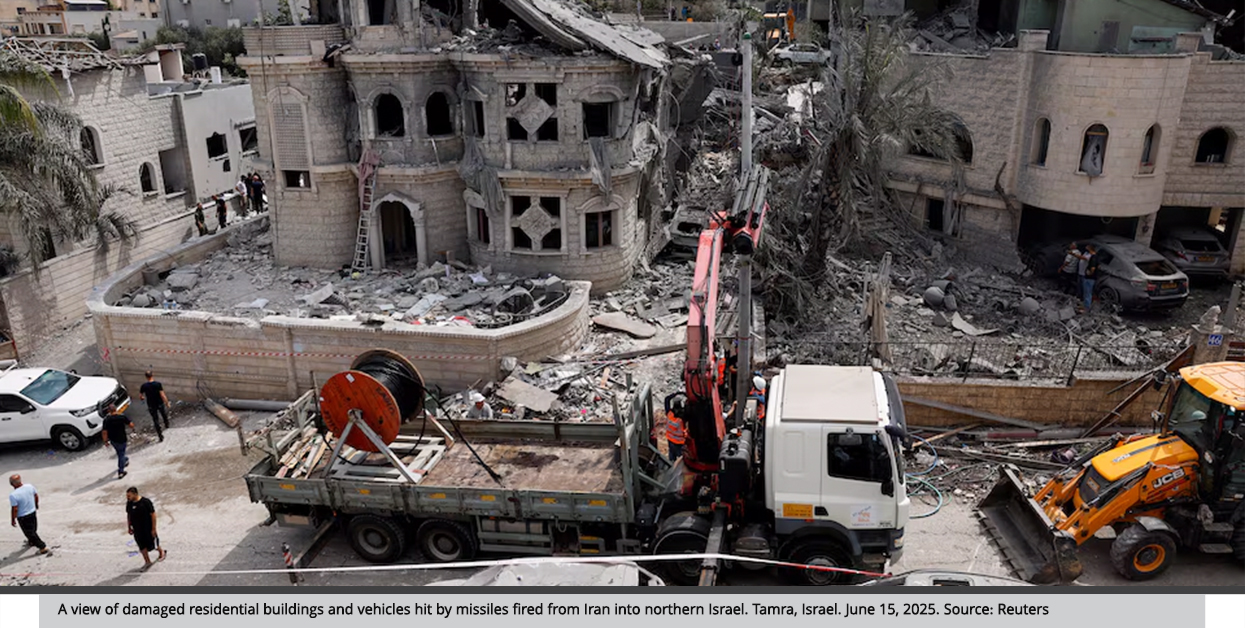
The Paths of the Israeli Military Operation
The Israeli attacks against the Iranian military command system and its defensive and offensive capabilities place the upcoming developments amid a set of trends and trajectories. These can be framed by looking at the overall events that have unfolded in the region and among Iran’s proxies since the outbreak of the war in Gaza, as well as studying the scale of the strikes themselves. These strikes do not appear to be mere isolated incidents or simple pressure tactics on Iran; rather, they primarily aim to solidify the post-war regional landscape and architecture. This situation presents a set of pathways, where the completion of one leads to the beginning of another.
First Trajectory: Pressure Continues to Urge Tehran to Make Strategic Concessions
In reality, the course of U.S.-Iran negotiations before 2015 was closely tied to applying pressure on Iran to compel it to make certain concessions. These pressures persisted even after the United States withdrew from the Joint Comprehensive Plan of Action in 2018 and implemented a “maximum pressure” policy aimed at escalating and deepening Iran’s economic crises.
However, after the war in Gaza, Israel began exerting direct military pressure on Iran or indirectly through targeting its allies. The United States indirectly joined this pressure campaign by aligning its political goals with Israel’s military escalation. Essentially, Israel has applied the maximum military pressure, while Washington aims to politically shape the outcomes of that pressure.
It is likely that Israel’s strategic strikes on Iranian nuclear, aerial, and military targets—and its efforts to paralyze Iran’s defensive and offensive systems—could push Iran to make major and strategic concessions in its military and nuclear doctrines. If so, the results could be reflected in the next round of U.S.-Iran negotiations, even if those talks are postponed.
These concessions might align more closely with American demands, particularly the complete halt of uranium enrichment. Notably, Israel’s past military strikes on Hezbollah’s leadership and military infrastructure led the group to compromise and accept the ceasefire agreement signed on November 27, 2024. In that agreement, Hezbollah agreed to decouple its agenda from Iran’s broader “Unification of the Arenas” project and abandon its military infrastructure stretching from the border to the Litani River.
Nevertheless, Iran seeks to obstruct the Israeli trajectory. This is evident in the shift toward targeting Israel’s home front as a direct battlefield in recent Iranian responses, most of which have focused on the central region—the “Greater Tel Aviv” area—where more than half of Israel’s population resides. This marks a departure from previous Israeli wars, in which the battlegrounds were primarily external fronts. It raises questions about Israel’s ability to endure prolonged, continuous Iranian strikes, a domain in which Iran has the upper hand due to its greater capacity for resilience and its tolerance for strategic losses, including key assets and leadership figures.
On the other hand, Israel may not possess the full capabilities needed to destroy Iran’s nuclear facilities outright. Rather, it is more likely to aim at disrupting and delaying the resumption of uranium enrichment for several months. Achieving complete destruction of the nuclear facilities would require direct American involvement in the operations—something for which no clear signs have emerged so far.
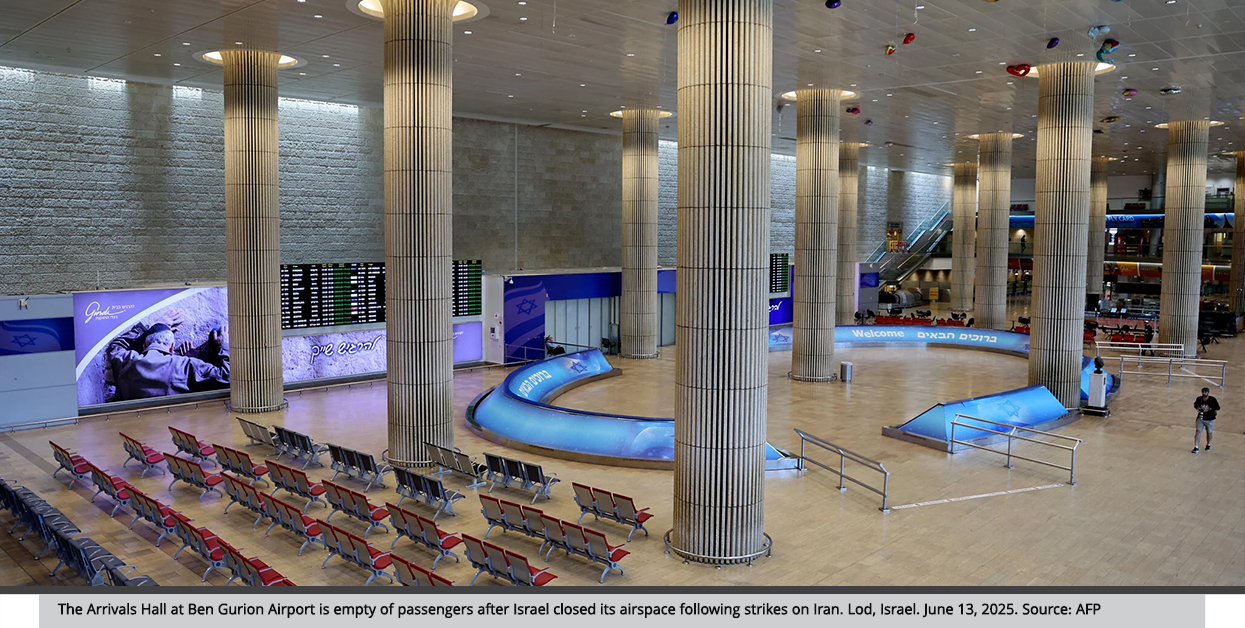
Second Trajectory: Moving Toward the Complete Destruction of Iran’s Military and Nuclear Capabilities
The scale of the attack that targeted the country’s military leadership and several political figures within the Supreme Leader’s establishment suggests that Israel is moving to replicate its strategy in Syria after the regime’s collapse in which it destroyed around 80% of Syria’s air, land, and naval military capabilities. This indicates that Israeli strikes are likely to continue until Iran’s military power is entirely dismantled or at least degraded to a level that prevents Tehran from posing any current or future threat, including through the complete destruction of its nuclear program.
Recent events and developments appear to be aligning with this trajectory. The paralysis within Iran’s defense infrastructure, the shock effect of the initial strikes, the destruction of air defenses, and the opening of Iranian airspace to Israeli military aircraft all provide a wide operational window to achieve these objectives and decisively shift the balance against Iran.
It is increasingly evident that the current situation is heading in this direction. This necessitates close monitoring of the scope and targets of upcoming Israeli strikes, which are expected to focus on what remains of Iran’s nuclear facilities—particularly the Fordow Fuel (uranium) Enrichment Plant—following the initial wave that targeted the Natanz nuclear site. These strikes also include above and underground ballistic missile production and storage sites.
The United States may also join the operations at this stage, given its superior destructive capabilities, especially since it has already prepared for such a scenario with its fleet of strategic bombers, including B-52s and B-2s, stationed in the region and on the joint U.S.-UK military base on Diego Garcia island.
Conversely, in recent days, Iran has revealed significant military capabilities that could have major repercussions for Israel, especially if they are directed at strategic Israeli infrastructure, whether security, political, or economic. Notably, during the June 15 attacks Iran employed hypersonic missiles with high explosive power, resulting in unprecedented scenes of destruction in the Bat area of Tel Aviv.
If such weapons are used against major economic assets or key military and air bases, Iran could seize part of the initiative in the ongoing escalation, potentially offsetting Israel’s initial superiority. This shift could compel Israel to scale back its military objectives and reconsider a return to the negotiation track.
Recent developments also indicate that the United States has stepped into the crisis, not as a participant in the military escalation, but as a mediator aiming to de-escalate tensions.
Third Trajectory: Moving Toward Creating a Power Vacuum Leading to Regime Change
The complete destruction of Iran’s offensive and defensive military capabilities could present Israel with an opportunity to push for regime change in Iran. However, this path is highly complex, multifaceted, and sensitive.
On one hand, the Iranian regime has already lost many of its national pillars, key leaders, nuclear and military capabilities, and the regional proxies it had relied upon for decades. Israeli strikes against Iran and its proxies since the outbreak of war on October 7, 2023, have severely undermined Iran’s nationalist narrative, a narrative that has long served as a core ideological foundation for the Supreme Leader and his hardline supporters.
If the current offensive, as outlined in the second trajectory, succeeds in fully neutralizing Iran’s military and nuclear assets, the regime’s ability to suppress any popular movement aimed at overthrowing it and replacing it with more moderate leadership would be significantly weakened. This is especially relevant given the regime’s past struggles in quelling mass protests, such as those that erupted after the death of activist Mahsa Amini in 2022. Nonetheless, it remains unlikely that the Iranian population would mobilize against its government amid an ongoing war.
Nevertheless, the success of this trajectory is tied to numerous complexities. First, it would leave Iran in a state of security and military vacuum until the strikes subside. Secondly, it assumes the Iranian people will respond by rising up against the regime. Netanyahu had already addressed the Iranian people on December 12, 2024, urging them to act to change their government.
However, such a shift could take months or even years and may not occur at all. Iran’s stance and history make it unlikely to accept regime change engineered by Israel. Any domestic movement aiming to seize this moment would likely struggle to gain the national legitimacy needed to lead such a transformation.
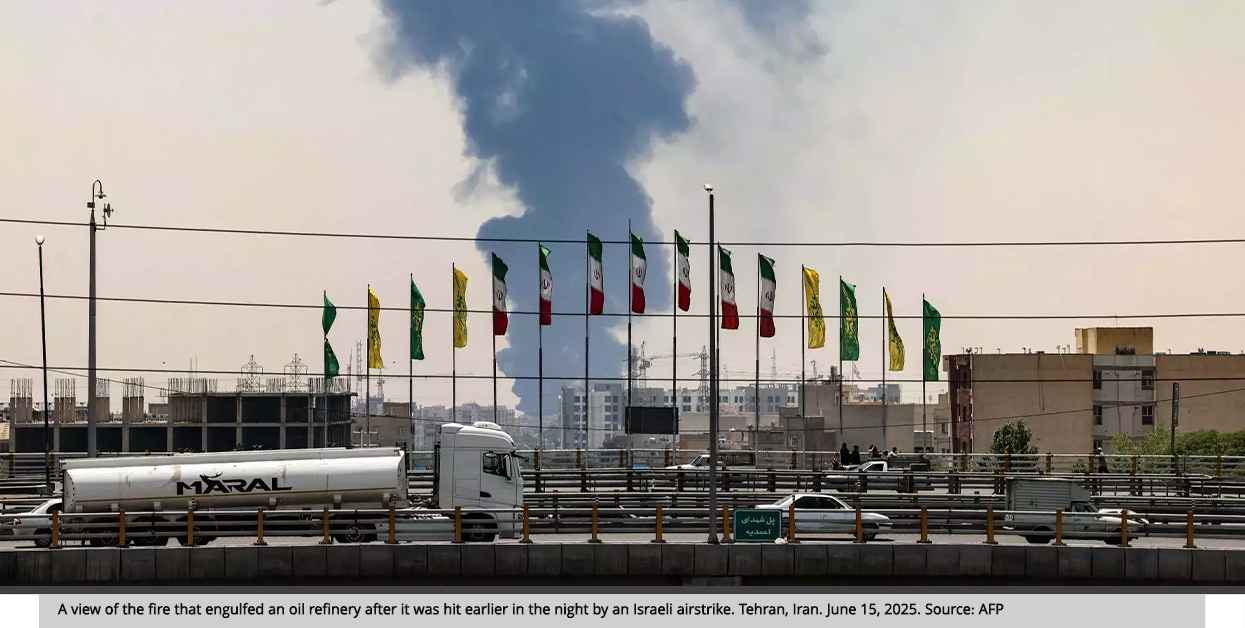
The second possibility involves replicating the U.S. experience in toppling the Taliban regime in 2001 when it supported an armed opposition movement. In Iran’s case, such a scenario could begin with armed opposition groups seizing control of border crossings—especially since many of them are already based in peripheral regions—and then gradually encircling the country, ultimately aiming to reach the capital, Tehran.
However, this remains an unlikely outcome, primarily because Iran’s armed opposition is largely composed of ethnic minorities. As a result, any such movement may lack broad popular support among the general Iranian population, which could quickly undermine its momentum and legitimacy, and prevent it from gaining national traction.
Regime change in Iran could, in theory, follow the model of Iraq in 2003, through a ground invasion by American and Israeli forces leading to the capture of Tehran, followed by the establishment of an alternative political system backed by opposition forces from both inside and outside the country. This option, however, is highly improbable.
Traditional wars of this scale are no longer publicly acceptable in the United States nor are they favored among its political elites. Washington now prefers indirect engagement in conflicts, as seen in its support for Ukraine against Russia and its current backing of Israel.
Moreover, such an operation would require enormous financial resources, the deployment of hundreds of thousands of troops, and many years—possibly decades—to achieve even a fragile form of stability. It would also risk triggering an armed resistance that could mirror the U.S. experience in Afghanistan, where the Taliban ultimately returned to power two decades after being ousted by American forces.
Finally, there remains the possibility that Iran may absorb the initial shock and seek to shift the strategic equation. To counter efforts aimed at subduing it through concentrated military force, Iran could initiate a strategic transformation in its doctrine by engineering a new “negotiation environment,” either from a position of weakness or by deliberately projecting internal vulnerability in response to external exposure.
This could involve a complex strategy allowing Iran to move from conventional retaliation to creating simultaneous theaters of engagement. For instance, it might ignite fronts in Yemen and Iraq through scattered tactical missions targeting American or Israeli military bases, or it may strike sensitive regional targets in retaliation for the use of neighboring airspace in attacks against it—or do both concurrently.
Iran could also escalate the conflict inside Israel itself by launching complex, behind-the-lines operations, such as cyberattacks followed by precision bombings or attacks on economic interests, infrastructure sabotage, and even targeted assassinations or strikes against vital systems like water and electricity networks.
Additionally, escalation could widen if international actors step in to support Iran, notably Russia, China, and North Korea, by providing military aid capable of restoring the balance of deterrence. Such support would extend Iran’s capacity for resilience and retaliation, potentially forcing Israel to make concessions and be the first to de-escalate in the ongoing conflict.

STRATEGIECS Team
Policy Analysis Team
 العربية
العربية
